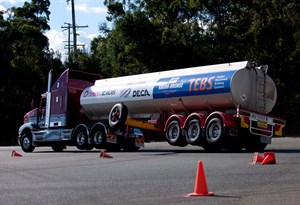Anti-lock and electronic braking systems are big issues, especially when it comes to trailers, and they got plenty of air at a recent conference.
ABS, EBS, ATC, ESC, ESP, DSC, RSS, LP, EBD, ACC … the list goes on when it comes to acronyms for the features you can get in modern braking systems.
It can all be very, very confusing, and is currently a little controversial too, with the Federal Government moving to mandate some of this stuff over the next few years.
ABS Explained
As we all know, anti-lock brake systems (ABS) have been around in new cars and trucks for many years now.
Under hard braking, they stop wheels locking up to prevent uncontrolled skidding.
In trucks, that means stopping distances are a bit longer, but control over the vehicle is maintained. It’s especially important for unloaded trucks and trailers.
But ABS technology in prime movers is almost becoming old hat. It’s reactive — in other words, the system reacts to an emergency situation after it has started happening.
The Federal Government recently mandated the fitting of ABS in all new prime movers. But this was hardly necessary, because almost 100 per cent of new rigs come with ABS anyway due to customer demand.
In fact, you’re a bit hard-pressed to find a new truck of whatever size that doesn’t also have the big advance on ABS, which is EBS — electronic braking system. EBS is also known as ‘brake by wire’.
What is EBS?
EBS detects and controls what’s going on with each individual wheel set.
That goes beyond dealing with the wheels locking up, because EBS is also predictive — pre-programmed sensors can help prevent a bad situation from happening in the first place.
One of the notable predictive functions is for rollover: EBS can predict that a rollover is about to happen, and apply the brakes differently to particular wheels to prevent it. In prime movers it can also slow down the engine speed.
This is part of what’s called a few different things depending on the manufacturer, but one name is Electronic Stability Program (ESP).
What is Electronic Stability Control?
Meanwhile, ESP or electronic stability control (ESC) also detects and minimises skids, with braking automatically applied to individual wheels, e.g. when going around a corner.
Then there is automatic traction control (ATC) and options such as electronic brake force distribution (EBD); active cruise control (ACC) which uses radar to control the distance between vehicles; and so on.
If these various EBS functions aren’t working for some reason, the underlying air brake system still works as normal.





